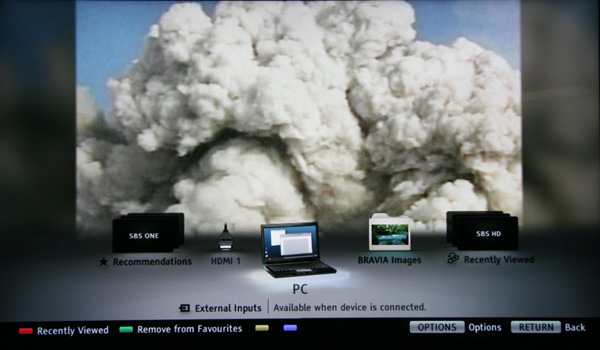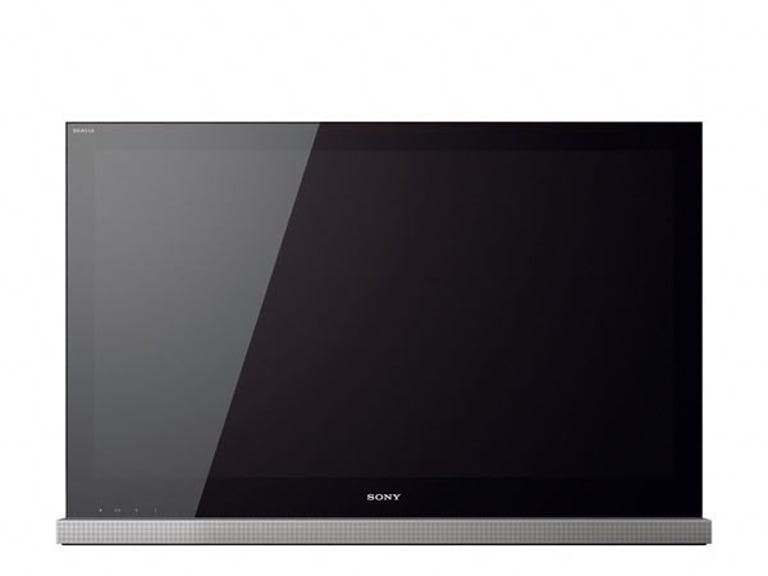 Why You Can Trust CNET
Why You Can Trust CNET Sony Bravia KDL40NX700 review: Sony Bravia KDL40NX700
With the Sony NX700 LCD television, the company has shown it's able to boil its best design and performance ideas down into what is arguably its finest Bravia yet.
Design has always been central to Sony's core, and while the past few ranges have looked quite slick we think the company's been lost in the wilderness when it comes to picture quality and value for money. However, could the NX700 be Sony's North Star — with its combination of design and performance — and guide it back on track?
The Good
The Bad
The Bottom Line
Design
Forget piano black, "borderless" designs are the current fashion with Apple, LG and now Sony leading the way. Of course, there is still a bezel on the NX700 as you still need somewhere to keep the panel's little flappy connector bits. But the panel is covered by a pane of glass which makes it look, in Sony's words, monolithic.
All of the controls are on the side of the TV and include a hard "off" switch which enables users to cut the energy usage of the TV to zero when not in use. The side profile isn't the slimmest we've seen, especially as the optional stand sticks out the back quite a way. But we've always been more interested in how the TV looks from the front anyhow.
The TV comes with a fairly innocuous swivel stand and if you use this option you'll be able to see the thin silver stripe at the bottom of the TV. Our preferred method is the optional table-top stand, which looks like a knife sharpener, but it also sets you back an additional AU$249. It's essentially a plastic/metal slab with a speaker grille at the front. Like the table-top stand, it also comes with a brace that helps you achieve a more suave slanted look. Sony says it has designed this six-degree tilt to enable the TV to be more comfortably viewed when put on a low-slung TV stand. We found that whether you use a low stand or a tall one the tilt feels unusual, and you are actually losing a very small amount of viewing area by watching it this way. But by joves, it looks cool!
We would have preferred a simpler system of changing from the angle of tilt on the optional stand, however, as it involves removing a bracket, taking out three screws, sliding the TV forward and then tightening the screws and bracket back on.
The bundled remote is a little different from Sony's previous models as the front is slightly concave. For some reason there is also a On/Off button on the back of the remote. While the remote is fun to use, we found it wasn't always the easiest to control as the difference between the four-way cursor and the surrounding buttons isn't pronounced — it's easy to hit the "Home" button instead of "Down", for example.
Features
While it may lack the all-dancing 3D features of the Sony TVs due in July, the NX700 still has a couple of magic tricks in its almanac. The 40-incher is a full-HD panel and features edge-lit LED technology for a brighter, "greener" picture. The television, like all of Sony's newest models, features internet connectivity and file streaming software. Sony has its own IPTV service called Bravia Internet Video, which promises to include catch-up content from providers including Yahoo7, SBS and ABC's iView in the coming months. At present users can access YouTube and Ford Models clips amongst other similar video services.
With the latest April update, Sony also brings us Yahoo widgets such as weather, Facebook and Twitter though the dedicated button on the remote doesn't currently work.
To help with the TV's connectedness, the NX700 includes both wired and wireless connections, and we were able to connect to our local WPA2 secured network without any hassles. Other connection options include four HDMI ports including two on the side and a single component connection. We didn't like the side mounts very much as we found that plugging cables into them ruined the TV's clean look, as you can see from our video. On the rear of the TV you also get two composite inputs, an optical output and a PC input.
The TV also comes with a number of picture enhancement technologies including Sony's Bravia Engine 3, "Live Colour" and 24p compatibility. The NX700 has 100Hz MotionFlow compensation, but if 200Hz is more your style then we'd say you should look at the NX800 instead. In our experience, Sony's 200Hz process is the best solution for sports enthusiasts.
Performance
Having dispensed with gimmicky features like wireless HDMI Sony has been able to concentrate on picture quality again, and this renewed focus is immediately apparent on the NX700. For your money, you'll get one of the sharpest, most involving pictures you're likely to see on any television this year. You may not get the black levels that perhaps deep sea creatures are used to, but the images coalesce into a pleasing whole.

The Favourites shorcut on the remote uses a pleasant overlay interface.(Credit: Ty Pendlebury/CBSi)
We began our testing with a battery of synthetic tests via our HQV Blu-ray disc and it passed everything bar our Film Mode (24p) benchmark. This should mean motion isn't quite as smooth when playing movie content from Blu-ray.
To test this we stuck the old chestnut Mission Impossible III into a Toshiba BDX2000 Blu-ray player and watched from the beginning of Chapter 11 — the "bridge scene". This lack of fluidity was evident as the camera tracks the convoy across the bridge at the beginning of the scene — a bit more judder here than we're used to. However, other video flaws such as noise, moire and blurring were not to be seen. In fact, colour, detail and black levels were some of the best we've seen from an LCD in a long time. This is a real return to form for Sony, which launched its first Bravia line with the claim it was "the best TV in the world". We won't make that same statement here, but the NX700 is indeed very good.
However, while most 1080p televisions are great with native content such as Blu-ray they can struggle with lower resolution stuff. No such problems with the Sony. The TV's high contrast levels helped give DVDs an almost 3D-like depth — without the glasses. It's able to reproduce colours faithfully with a minimum of noise and no judder whatsoever. In fact, its abilities with DVD almost surpass those of Blu-ray.
Sound quality is another positive aspect of this television's performance. Dialogue in particular is natural and a lack of extraneous mid-range noise renders voices with an intimacy that Sony's rivals cannot muster. It perhaps didn't have the low-end bluster of other sets with dedicated speakers, but if you're looking for detail we'd suggest getting the optional stand — it channels the downward-firing speakers into your ears for better sound.
The menu uses Sony's well-worn Xross Media Bar (XMB) to good effect, with a number of different functions tied together conveniently into a "one-stop shop". For example, we appreciated the ability to access internet functions from the XMB. It's as easy to browse YouTube as it is to view One HD. On a related note, we were impressed by the TV's ability to perform sophisticated overlay effects when engaging certain functions: both the XMB and the Favourites shortcut presented full-colour information on-screen without interrupting program material.
Last month, Sony announced a partnership with Yahoo7 which means access to "on-demand" content from Channel 7, but at the time of writing this it wasn't up and running. Instead we watched some of the selection of content on offer from YouTube and partners such as Wired and Ford Models. There aren't any "linear channels" as such yet, only short videos, but the quality was acceptable. It took a while for the TV to download the available channels — over five minutes — but after that the process was smooth.
If you're not ready for internet channels and you want to "kick it old school" then you'll be gratified to know the television has a high quality tuner on-board. Pictures showed good detail, and the unit has the best EPG we've seen. It features a clean layout with live Picture-in-Picture (PIP). The aforementioned Favourites button is awesome with cute icons, and it lets you store not only your favourite channels but inputs and IPTV channels as well.
We found our experience with the Sony to be a highly positive one, but there were a couple of things that prevented it from getting a higher score. Firstly, the screen uses a high-contrast filter which helps to boost black levels, but as a result it is also quite reflective. On dark scenes you may want to bring the house lights down or risk watching yourself floating over the proceedings like a sedentary ghost. There was also some small "backlight clouding" issues in one corner of the television which was only noticeable on a dark screen. To this end, the off-axis will never be as good as a plasma, with some loss of contrast off-axis though which is not too bad.
Widgets were also a disappointment — they were slow, slow, slow, and this extended to every part of the experience, including the on-screen keyboard. We did try tweeting from the TV but found it was a horrifying experience. Give us large-screen video experiences such as YouTube and catch-up TV and leave tweeting and Facebook to portable devices we say.
Conclusion
With looks and performance to die for we think that Sony has shown it's capable of stepping back a bit and coming up with a killer television without too much extraneous gumpf. By choosing to add features such as IPTV, DLNA streaming and widgets the company has hack-sawed a hole in our lounge room wall that will eventually let in the future.
The Bravia NX700 is available in two panel sizes: the 46-inch model is AU$3699 RRP and the 40-inch model is priced at AU$2999. The stand shown here in the image gallery will cost a further AU$250-350, depending on the size required.
Its companion Bravia NX800, is essentially the same unit, with the exception that it has 200Hz MotionFlow technology on-board, whereas the NX700 has 100Hz MotionFlow. The NX800 is offered in two larger screen sizes — 52 inches (AU$4999) and 60 inches (AU$6999).


